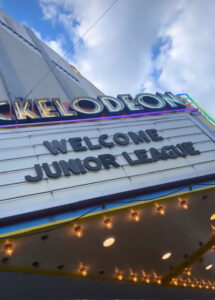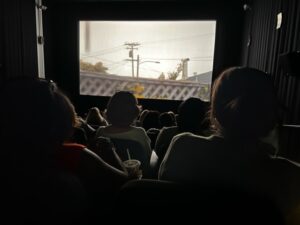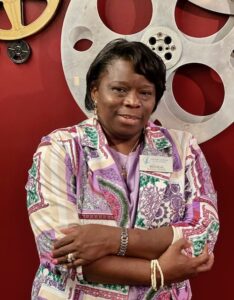Illiteracy: A Community Issue
The Public Affairs Committee partnered with the Nickelodeon Theatre to hold a community event highlighting a nationwide issue of illiteracy. This issue has not bypassed the children in our community. According to WACH Fox 57, across the State, around 25 percent of students scored below average on the South Carolina Ready read and writing exam. The scores were even more disparaging for some of the counties in the Midlands: Orangeburg County School District – 44 percent, Lexington School District Three – 31 percent, Richland School District One – 35 percent, and Sumter School District – 40 percent below average (Jordon, 2023). 
The Right to Read is a documentary film by Jenny Mackenzie that highlights the issue of illiteracy in the United States and why children are struggling to read. The film centers around 4 main groups – an NAACP activist, a teacher, and two families – while interweaving literacy statistics and the way this fundamental skill is taught in American schools throughout the country. This is not a new fight facing the American family and education system. The film points out that the education system is teaching reading and comprehension in a way that has proven not to work and highlights a different method, a phonics-based approach, that seems to be more successful in helping children be able to read.
After screening the film, the Public Affairs Committee hosted a panel filled with educational leaders in the Midlands. Kim Leighton, a current Junior League of Columbia, Inc. Board Sustainer Representative and former Junior League of Columbia President, moderated a Question-and-Answer session with the panelists. The panel consisted of Dr. Catherine Compton-Lilly, Selina Latimore, Kavon Barger, and Caroline Clarkson. Dr. Catherine Compton-Lilly is the distinguished John C. Hungerpiller professor in the College of Education at the University of South Carolina. She has published numerous articles and books focused on reading and is currently working with a group of graduate students to follow children of immigrant families from primary school through high school (Faculty and Staff, n.d.). Selina Latimore is a principal at John P. Thomas Elementary School with the Richland One School District. Kavon Barger is the Richland One’s 2023-2024 Teacher of the Year and is a second-grade teacher at A.J. Lewis Greenview Elementary School (Richland One Employee Profile, 2023). Caroline Clarkson is a Junior League Sustainer and local Educator.

The panel utilized their various insights and experiences to point out some thought-provoking and challenging ideas to accompany the information presented in the documentary and to further the discussion on literacy. Overall, the panel highlighted that there is no one way to teach students. It’s a combination of different approaches that should be tailored to each student. If diversity and equity is really about differences, then those differences should be at the center of teaching reading comprehension. A “one size fits all” solution will not work. Teachers must utilize multiple approaches. Until that happens, all children won’t be reached. Teaching reading and comprehension is not just on the teacher, but it’s a team effort between the school district, family, and the community. This process takes time. It won’t happen overnight. Those working with children who are trying to learn how to read must be intentional, encouraging, and patient. Don’t be afraid to think outside the box and make it fun and relatable for the child.
The audience was moved by the information presented in the film and engaged in dialogue with the panelists. One audience member in particular, Wanda Austin, brought up the interconnectedness of inequities in other areas, not just literacy, facing kids when she asked about how we can incorporate the literacy data to possibly address food and nutritional inequalities, such as food desserts. Austin has worked with Parks and Recreation for 24 years. Local parks departments can work with kids on different levels and teach through play. However, if kids are hungry or consuming overly processed foods, they can’t focus and disconnect due to chemical imbalances. “This is not just a school and teacher issue. It’s a community issue.” Austin plans to take the information and data she learned at the screening to the various committees she is on and approach these issues collaboratively by keeping the focus on the kids.
panelists. One audience member in particular, Wanda Austin, brought up the interconnectedness of inequities in other areas, not just literacy, facing kids when she asked about how we can incorporate the literacy data to possibly address food and nutritional inequalities, such as food desserts. Austin has worked with Parks and Recreation for 24 years. Local parks departments can work with kids on different levels and teach through play. However, if kids are hungry or consuming overly processed foods, they can’t focus and disconnect due to chemical imbalances. “This is not just a school and teacher issue. It’s a community issue.” Austin plans to take the information and data she learned at the screening to the various committees she is on and approach these issues collaboratively by keeping the focus on the kids.
There are several ways the community can get involved. One of the first ways is through community events like this one. These can provide opportunities to bring solutions to the table. Latimore discussed a partnership between the school district and City Year through AmeriCorps. This partnership is used as a pipeline into teaching and helps address the teacher shortage. Clarkson highlighted several programs that the League has done in the past or still conduct. Some of these include book giveaways for kids, ABCs, and meal and educational nights. The ABCs program at one time gave kids seasonal books (D for dictionary) but has since focused on Dental hygiene for the D. The meal/educational nights helped make schools not seem as intimidating for parents. Binging parents into the schools was powerful.
Other ways to get involved is to get in the schools. Every school needs support. Community members can always go or reach out to a school and ask how can an individual or community members help that school. Business partnerships are also important for schools. There are opportunities for churches to read with the kids. College student athletes can participate by coming in and reading. This helps kids discover the value of reading from those they admire. Bringing in different people into the classroom to read with students exposes them to various professionals and how reading is important to that profession. Individuals in the communities can also advocate with their local representatives regarding educational legislation that is moving through the legislative process.
Illiteracy is one of the most solvable problems of our time. Focus should be on the children, not the program. As individual community members and League members, don’t be afraid to go out and into local schools to volunteer. Most importantly, don’t be afraid to commit. Once you decide how you want to get involved, just stick to it and do it.
For more information on The Right to Read, please visit https://www.therighttoreadfilm.org/.
To access literacy data and other statistics regarding children in South Carolina, please visit SC Children’s Trust at https://scchildren.org/.
For more information regarding current legislation, please visit https://www.scstatehouse.gov/legislation.php.
To learn more about other films and community events being held at The Nickelodeon Theater, please visit https://nickelodeon.org/.
Sources
Jordon, K. (2023, August 2). Large Subgroup of South Carolina students inefficient in reading comprehension and literacy. https://wach.com/news/local/large-subgroup-of-south-carolina-students-inefficient-in-reading-comprehension-and-literacy
Faculty and Staff: Catherine Compton-Lilly, Ed.D. (n.d.) University of South Carolina. https://sc.edu/study/colleges_schools/education/faculty-staff/compton_lilly_catherine.php
RICHLAND ONE EMPLOYEE PROFILE: District Teacher of the Year Kavon Barger Ensures His Students are Loved and Supported (2023). Richland One. https://www.richlandone.org/site/default.aspx?PageType=3&DomainID=4&ModuleInstanceID=56&ViewID=6446EE88-D30C-497E-9316-3F8874B3E108&RenderLoc=0&FlexDataID=45501&PageID=1


